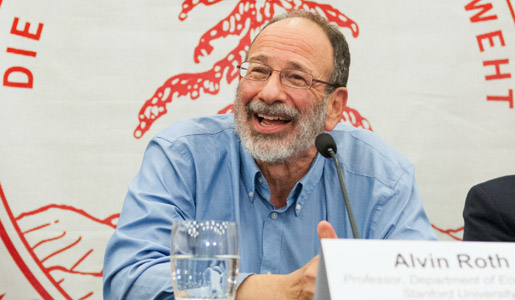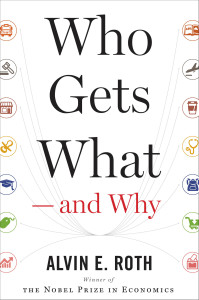An algorithm that matches kidney patients and donors
The link above will take you to the four-minute version of the fifty minute Freakonomics podcast in which Dubner interviews me about my new book.
I'll post market design related news and items about repugnant markets. See also my Stanford profile. I have a general-interest book on market design: Who Gets What--and Why The subtitle is "The new economics of matchmaking and market design."



 STEPHEN J. DUBNER
STEPHEN J. DUBNERROTH: I was, you know, a poor ungrateful student who didn’t appreciate what my teachers were trying to do for me. You should tell all your listeners they should complete high school.
ROTH: Matching markets are markets where money, prices don’t do all the work. And some of the markets I’ve studied, we don’t let prices do any of the work. And I like to think of matching markets as markets where you can’t just choose what you want even if you can afford it — you also have to be chosen. So job markets are like that; getting into college is like that. Those things cost money, but money doesn’t decide who gets into Stanford. Stanford doesn’t raise the tuition until supply equals demand and just enough freshmen want to come to fill the seats. Stanford is expensive but it’s cheap enough that a lot of people would like to come to Stanford, and so Stanford has this whole other set of market institutions. Applications and admissions and you can’t just come to Stanford, you have to be admitted.
LEISHMAN: It’s saving a lot of lives. We have about 600 kidney-paired donation transplants a year right now in the United States. In 2000, we had 2. … We would have stayed doing 2 or 4 or 6 a year without the algorithm.
 Working Capital Conversations: Leading thinkers, practitioners and experts discuss the ideas that drive global business.
Working Capital Conversations: Leading thinkers, practitioners and experts discuss the ideas that drive global business. The ideas seem laughable. Yet we live in an era that celebrates free markets and seems to celebrate the role of pricing in markets. But thanks to a range of factors – some old, like tradition; some new, like smart phones – new markets are popping up everywhere. And they’re not always developed by the traditional free market rules or price dynamics.
The ideas seem laughable. Yet we live in an era that celebrates free markets and seems to celebrate the role of pricing in markets. But thanks to a range of factors – some old, like tradition; some new, like smart phones – new markets are popping up everywhere. And they’re not always developed by the traditional free market rules or price dynamics."Marketplace Innovation" WorkshopConference Organized by Ramesh Johari, Costis Maglaras, and Gabriel WeintraubWednesday, June 10, 2015 from 9:00 AM to 3:00 PM (EDT) |